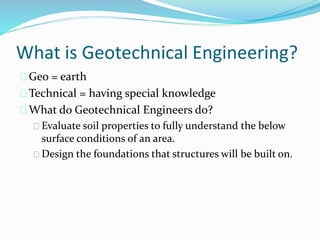The 7-Minute Rule for Geotheta
The 7-Minute Rule for Geotheta
Blog Article
The Ultimate Guide To Geotheta
Table of ContentsGeotheta Can Be Fun For EveryoneLittle Known Facts About Geotheta.Not known Facts About GeothetaGeotheta Things To Know Before You Buy
They collaborate with civil designers, architectural engineers, architects, and various other professionals to integrate geotechnical factors to consider into the general job style and construction procedure. This calls for reliable teamwork, control, and interaction to guarantee that the geotechnical facets align with the task objectives and meet regulative requirements.Mining & Products Engineering: Principles of drilling, infiltration prices, and aspects impacting the selection of exploration method. Characteristics of explosives, firing systems and blast patterns. Blowing up techniques in surface area and underground operations. Special blasting methods at excavation perimeters. Resonance and sound control. Mechanical and continual techniques to fragmentation, including longwall shearing and fullface boring.
Integrated evaluation of fragmentation and comminution operations. Supplied by: Mining & Products Engineering.
Rumored Buzz on Geotheta
Bachelor's degree programs in civil, geotechnical, geological, and environmental design normally last 4 years and consist of basic education and learning courses in English, social scientific research, and the liberal arts, along with training courses in advanced maths, structural geology, and fluid mineralogy. (https://www.openstreetmap.org/user/geotheta)
Geotechnical engineering involves the analysis of the soil and rock conditions at a certain website, and their implications for the advancement of that site. As many frameworks rely upon the ground for assistance, it is without shock that an in-depth understanding of the ground problems, and the suitability of structure systems, are crucial to the long-lasting security and efficiency of the building or framework.
Being experts in the examination of geological developments and ground behaviour, geotechnical engineers execute scientific investigations and testing to comprehend the impact these geological developments may carry the layout and construction of building, civil and facilities jobs. This know-how is essential for the layout and building of structures, roadways, passages, dams, bridges, and supply of water and sewer system.
The geotechnical group at Douglas Partners consistently talk to designers, style designers, programmers, and home builders to make recommendations on design and development propositions to make sure that the developed structures are suitably developed for the ground conditions. As an example, the design of footing systems requires to consider the weight of the structure, the capacity of the ground to support that weight along with motion tolerances and reliable construction.
Geotheta Can Be Fun For Everyone
This task is significantly simplified by the use our Douglas Map geospatial platform which makes this details readily easily accessible in an easy to utilize internet browser user interface. A geotechnical designer will certainly route the boring of boreholes and test pits to collect dirt and various other samples, and additionally evaluate surface area features and ground direct exposures to develop a geotechnical version of the subsurface problems.
Relying on the project type and ground problems experienced, research laboratory testing may to name a few points evaluate toughness, compressibility, sensitivity and/or leaks in the structure of dirt and rock examples. After this information is gathered and looked at, the outcomes are used for a geotechnical version of the site, which is typically provided as areas across the site.

A geotechnical investigation naturally can only analyze the ground conditions at the areas drilled or dug deep into. Natural variations in visit our website dirt and rock problems can take place throughout a website and in between test locations. It is therefore good method that the geotechnical engineer be maintained throughout construction of the job to provide on-site verification that the ground conditions come across are constant with the expectations and advice offered in the geotechnical examination record.
The Of Geotheta
Geotechnical designers use their thorough expertise of dirt and rock to assess threat and solve troubles on varied framework projectsGeotechnical engineering is a specialist branch of civil engineering which takes a look at the behavior of planet materials and the application of dirt and rock technicians. Geotechnical Engineers. As a geotechnical engineer, you will analyze the physical, mechanical and chemical residential properties of dirt and rock in order to create structures, retaining frameworks and earthworks
Geotechnical engineering is very closely connected to and overlaps with, both design geology and ground engineering - https://www.dreamstime.com/ianhammond2191_info. It's possible to be experts in geotechnics or work for a geotechnical business but be referred to as an engineering rock hound or a ground engineer. As a geotechnical engineer, you'll need to: construct and keep relationships with clients and various other experts associated with the website, throughout each projectmaintain safety standards on website be conscious of cost implications when you make recommendationsstudy geological maps and airborne photographs from a variety of resources and from different time periodsexamine building intends to see exactly how practical they are based on your understanding of the siteinvestigate dangers or geological hazards for the sitesearch for eco sensitive features, such as garbage dump start to develop accurate and interpretive ground modelsplan field investigationsdrill and evaluate samples of bedrock, dirt, groundwater and added products manage various other experts on sitesolve technological problems as they emerge, such as unexpected structures at drill sitesmonitor problems during and after building to make sure structures are stable in the brief and long termadding data collected on website to your preliminary researchcreating geotechnical calculations, drawings, and 2 or three-dimensional computer system versions analyzing the datamaking referrals about the proposed use the site

Report this page